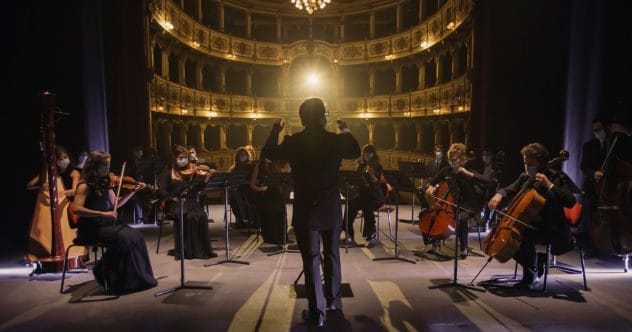In the world of classical music, some premieres have not only shaped history but also deeply divided audiences and critics. These performances dared to challenge the norms of their time, sparking reactions from awe to anger. Let’s explore some of these groundbreaking debuts, which, despite initial skepticism, have earned a place of honor in music history.
The 10 Most Polarizing Classical Music Premieres
These premieres pushed boundaries, challenged norms, and ultimately redefined classical music. Here are ten of the most pioneering and polarizing premieres in classical music history:
10 Igor Stravinsky’s The Rite of Spring
The premiere of Igor Stravinsky’s The Rite of Spring on May 29, 1913, at the Théâtre des Champs-Élysées in Paris, ignited one of music history’s most infamous riots. Its complex rhythms, dissonant harmonies, and primitive themes challenged the audience’s understanding of ballet and orchestral music.
The performance caused a near-riot, with supporters and critics engaging in physical fights, and the audience’s noise sometimes drowned out the orchestra. Vaslav Nijinsky’s choreography, combined with Stravinsky’s score, broke from traditional ballet music and storytelling. While some praised its innovation, others condemned its discordance and departure from classical norms.
Despite the initial uproar, The Rite of Spring is now celebrated as a pivotal work that began a new era in music, influencing many composers and establishing Stravinsky as a leading composer of the 20th century.[1]
9 Arnold Schoenberg’s Pierrot Lunaire
Arnold Schoenberg’s Pierrot Lunaire premiered on October 16, 1912, in Berlin. This atonal masterpiece for voice and small ensemble, based on Albert Giraud’s poems, introduced Sprechstimme, a vocal style between speaking and singing. Schoenberg’s move from tonality to atonality challenged perceptions of music and harmony.
The premiere was both critically acclaimed and controversial. Audiences were divided over Schoenberg’s innovative techniques and dissonant harmonies. Some praised it as revolutionary, while others struggled with its abstract forms and emotional intensity.
Despite mixed reactions, Pierrot Lunaire is now seen as a seminal work of the early 20th century, significantly influencing modern music and setting the stage for Schoenberg’s later work in twelve-tone composition. Its polarizing debut highlights the challenges and rewards of embracing new artistic ideas.[2]
8 John Cage’s 4’33”
John Cage’s 4’33” premiered on August 29, 1952, at the Maverick Concert Hall in Woodstock, New York. Performed by pianist David Tudor, the piece involves four minutes and thirty-three seconds of silence, where the ambient sounds become the music.
Cage’s piece was met with confusion, outrage, and intrigue, with many questioning if it could be considered music. Despite its polarizing nature, 4’33” has become one of the most famous and important pieces of the 20th century. It’s celebrated for its embrace of silence and its philosophical implications on sound and listening.
Cage’s work questions the boundaries of musical composition and the audience’s role in the musical experience, making 4’33” a landmark event in avant-garde music.[3]
7 George Crumb’s Black Angels
George Crumb’s Black Angels premiered on May 13, 1970, by the New York String Quartet at the University of Michigan. This electric string quartet is a haunting reflection on the Vietnam War era, exploring timbre, extended technique, and theatricality, using electronic effects and unconventional instruments.
The premiere was met with awe and discomfort, as audiences were unaccustomed to such an intense portrayal of conflict and spirituality in classical music. Its innovative use of electric instruments and thematic darkness positioned Black Angels as a groundbreaking work.
Despite its challenging nature, Black Angels is regarded as one of the most significant American works of its time, embodying the societal unrest and quest for understanding of the era. It remains a powerful testament to music’s capacity to reflect cultural and political landscapes.[4]
6 Karlheinz Stockhausen’s Gesang der Jünglinge
Karlheinz Stockhausen’s Gesang der Jünglinge premiered in 1956 at the West German Radio in Cologne. It’s a landmark piece in electronic music, blending human vocal sounds with electronic tones, based on the biblical story of the fiery furnace, using a boy soprano’s processed voice.
Stockhausen’s composition stands out for its innovative use of electronic music technology to create a complex auditory experience. The reception was mixed, with some praising Stockhausen’s revolutionary approach to sound design, while others were perplexed by the unfamiliar sounds and lack of traditional structures.
Despite its divisive debut, the piece is recognized as a pivotal work in the development of electronic and acousmatic music, influencing many composers. Stockhausen’s work challenged conventions and expanded the possibilities of musical expression in the electronic age.[5]
5 Luciano Berio’s “Sequenza III” for Solo Voice
Luciano Berio’s “Sequenza III” for solo voice premiered in 1966, performed by mezzo-soprano Cathy Berberian. It’s a masterpiece of vocal experimentation, exploring the human voice’s capabilities. This piece uses laughter, whispers, cries, and linguistic fragments to create a vivid and emotionally charged soundscape.
The premiere was met with astonishment as audiences encountered a work that stretched the boundaries of traditional vocal music. Berberian’s performance challenged conventional notions of musicality, dividing critics and listeners.
Despite its polarizing debut, “Sequenza III” is celebrated for its use of the voice as an instrument of pure sound. Berio’s work opened new avenues for vocal composition, marking a pivotal moment in modern music’s evolution.[6]
4 Pierre Boulez’s Le Marteau sans Maître
Pierre Boulez’s Le Marteau sans Maître premiered in 1955 at the International Society for Contemporary Music in Baden-Baden, Germany. This composition for voice and ensemble, based on René Char’s surrealist poetry, integrates non-Western instruments into Western art music.
The premiere was a polarizing event, with some unable to grasp Boulez’s serialism and the interplay between music and poetry. Some saw the work’s dense textures as challenging, leading to debates about classical music’s direction.
Despite initial resistance, Le Marteau sans Maître has been recognized as expanding the possibilities of musical form and rhythm. Boulez’s masterpiece has influenced composers, securing its place as one of the most important works of the 20th century.[7]
3 György Ligeti’s Atmosphères
György Ligeti’s Atmosphères premiered in 1961 at the Donaueschingen Festival in Germany. This piece for full orchestra eschews conventional melody in favor of dense sound textures and micro-polyphonic techniques, creating a seamless flow of “static music.”
The premiere left audiences in awe and bewilderment. Some were captivated by its use of the orchestra to create a complex soundscape, while others were unsure how to react to a piece that defied expectations.
Atmosphères has since been recognized as influential, especially after its use in Stanley Kubrick’s 2001: A Space Odyssey. The premiere showcased the endless possibilities of sound and the avant-garde’s relentless pursuit of the new.[8]
2 Milton Babbitt’s Philomel
Milton Babbitt’s Philomel, which premiered in 1964, is a pioneering work for soprano, synthesized sound, and tape. Based on Ovid’s Metamorphoses, it integrates live performance with prerecorded sounds, creating a dialogue between human and machine.
The premiere was a landmark in integrating electronic technology into classical music. Audiences were confronted with a landscape where distinctions between live and electronic were blurred. Babbitt’s work was praised for innovation but critiqued for its cold electronic elements.
Despite mixed reception, Philomel is now recognized as a seminal piece in electronic music, showcasing the potential for new technology to expand classical music’s capabilities.[9]
1 Louis Andriessen’s De Staat
Louis Andriessen’s De Staat premiered in 1976 and is a compelling work reflecting the composer’s critique of Plato’s views on music from The Republic. Andriessen combines minimalism, repetitive structures, and driving rhythms with jazz and rock influences.
The premiere was a provocative event, challenging audiences with its integration of genres and political message. Some were enthralled by Andriessen’s approach, while others were less receptive.
Over time, De Staat has been recognized as a landmark work, inspiring discussions on music’s role in society. The premiere stands as a testament to Andriessen’s vision of a new musical language that is both reflective and transformative.[10]
These premieres demonstrate how classical music has evolved by challenging conventions and integrating diverse influences. Each piece, initially met with skepticism, has found its place in music history.
What are your thoughts on these groundbreaking classical pieces? Leave your comment below!










